Order these records by:
Browse Collection › LC Subject Heading › 14 records found where LC Subject Heading is African Americans -- North Carolina -- Durham -- 19th century | ||
 | Chas. Emerson’s North Carolina tobacco belt directory 1886 (Excerpt) This excerpt from the 1886 directory lists Durham County's land owners. Each entry includes the landowner's name, the location of the nearest post office, and the number of acres the individual owned. Individuals with African American heritage are denoted by an asterisk (*). The directory identifies 16 post offices in Chapel Hill, Dayton, Durham, Fish Dam, Flat River, Hillsboro, Kunkadora, Luster, Lyndover, McCown, Morrisville, Mount Tirzah, Orange Factory, Red Mountain, Staggville, and South Lowel. Advertisers include John L. Markham; Robertson, Lloyd and Co.; and the Durham Recorder. | |
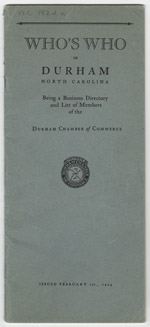 | Who's who in Durham, North Carolina ,being a business directory and list of members of the Durham Chamber of Commerce This 1924 Durham Chamber of Commerce publication contains information about the Chamber and its membership. The pamphlet provides an alphabetical listing of individual members, a classified business directory, and a section of “facts about Durham.” | |
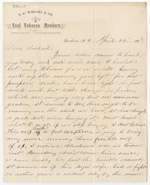 | Letter from Thomas D. Wright to Richard Harvey Wright, April 26, 1886 Thomas D. Wright describes an altercation and "fight" between two women and the public's response to Mr. Blackwell's sudden departure to Raleigh. | |
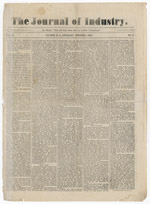 | Oration on the occasion of the Second Annual Exposition of the Colored People of North Carolina, delivered on October 1, 1880 Frederick Douglass delivered this “Oration on the occasion of the Second Annual Exposition of the Colored People of North Carolina” in Raleigh, North Carolina on October 1, 1880. Douglass offered his vision of economic progress for black farmers living in the South. Charles Hunter, editor of the Journal of Industry reprinted the oration in his newspaper and included other news stories about the Exposition. | |
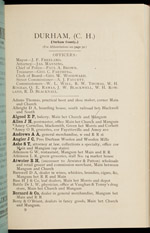 | Chas. Emerson’s North Carolina tobacco belt directory 1886 (Excerpt) This section of Emerson's 1886 directory lists businesses within the corporate limits of the town of Durham.The directory lists the names of proprietors, stores' locations and the products sold. Individuals with African American heritage are denoted by an asterisk (*). | |
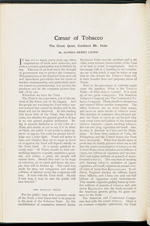 | Caesar of tobacco : the great, quiet, confident Mr. Duke Biographical portrait of James Buchanan Duke, with a focus on his leadership role in the American Tobacco Company and the Continental Tobacco Company. | |
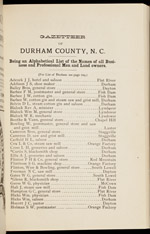 | Chas. Emerson’s North Carolina tobacco belt directory 1886 (Excerpt) This section of the 1886 directory entitled, Gazetteer of Durham County, North Carolina, lists 70 Durham County merchants and land owners, together with the name of the post office located nearest their businesses. Individuals with African American heritage are denoted by an asterisk (*). Occupations include hotel and saloon keeper, shoe maker, general store keeper and grocer, postmaster, mechanic and blacksmith, minister and pastor, saw and grist mill owner, physician, and cotton ginner. | |
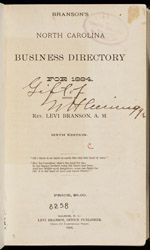 | Branson's North Carolina business guide This section of the guide contains physical attributes, land values, livestock values, taxes, and population statistics for Durham County. Branson notes that Durham County's population was 13,000, of which 8,500 were white and 4,500 were black. Also provided are the towns that had a post office, as well as county officers, court hearings, townships, magistrates, churches, pastors, and denominations. For individuals, Branson lists the name, nearest post office, and occupation. Edward James Parrish and Blackwell's Warehouse bought advertising space in the guide. | |
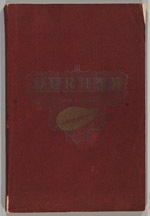 | Hand-book of Durham, North Carolina : a brief and accurate description of a prosperous and growing southern manufacturing town This pocket-sized handbook documents the people, businesses, social conditions, and government of Durham, North Carolina, and compares Durham's industrial and social advantages to other cities of the same size. It includes statistical records and information about Durham's government, health, real estate, taxes, buildings, streets, waterworks, fire departments, electric lights and gas, telephones, hotels, hospitals, markets, schools and colleges, churches, lodges, and social clubs. Included are lithographs of Mangum Street and Main Street and depictions of prominent buildings, such as: Bennett Place; Durham County Court House; the Fire House; Hotel Carolina; City Hospital; Durham Graded School; Trinity College's Main Building; Trinity Methodist Church; Main Street Methodist Church; the Presbyterian Church; the First and Second Baptist Church; bank buildings; the factory of the Blackwell Durham Tobacco Co.; Duke Tobacco Factory; and textile factories. Portraits include Isaac N. Link, ma... | |
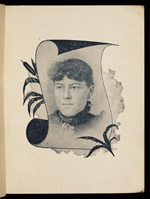 | My thoughts : A book of poems. With an introduction by James E. Shepard. M. Pauline Fitzgerald, one of Durham’s first African American school teachers, penned this self-published book of poetry. Pauline’s poetry memorializes Frederick Douglass, Dr. H. M. Tupper, founder and first president of Shaw University, and Bishop Daniel Payne of the A.M.E. Church. The collection also includes some more personal pieces including “An Ode to the First Colored Drug Store in Durham, North Carolina” and “The School Mistress.” Pauli Murray, author of Proud Shoes: The Story of an American Family relates a number of stories about her “Aunt Pauline” in her biographical account of M. Pauline Fitzgerald’s parents, Robert G. and Cornelia Fitzgerald. | |
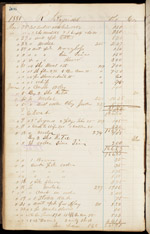 | Richard Fitzgerald account These pages from the Atlas M. Rigsbee, General Store ledger indicate what products, Richard Fitzgerald purchased from the Atlas M. Rigsbee General Store in 1880. Fitzgerald, an African American brickmaker, purchased a range of goods including foodstuffs like flour, meal, butter, sugar, and fish as well as lamp chimneys, collars and hats. The ledger indicates that Fitzgerald paid for his goods with bricks from his manufacturing enterprise. | |
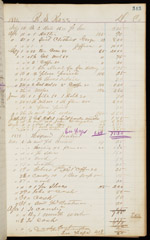 | Haywood Jenkins account These financial records indicate what products Haywood Jenkins, an African American factory hand, purchased from the Atlas M. Rigsbee general store in 1880. This ledger account provides information about the cost and availability of foods like meal, fish, lard as well as tobacco and snuff. The account indicates that Haywood Jenkins purchased goods in exchange for his labor. | |
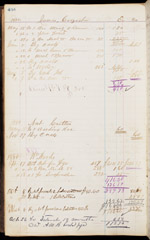 | James Cozart account These financial records indicate what products James Cozart, an African American farmer, purchased from the Atlas M. Rigsbee general store in 1880. This ledger account provides information about the cost and availability of staple foods like bacon, corn, and meal as well as hardware like plow points. | |
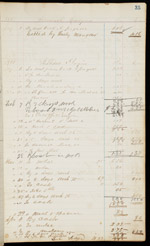 | William Hogan account These financial records indicate what products William Hogan, an African American farm laborer, purchased from the Atlas M. Rigsbee general store in 1880. This ledger account provides information about the cost and availability of staple foods like bacon, corn, and meal as well as coffee, sugar, tobacco, and ham. The account also reveals that Hogan paid for his goods with his labor. | |
digitaldurham@duke.edu · About this site · Copyright © 2001 - 2006. Trudi J. Abel. All Rights Reserved.
The copyright interest in the material in this digital collection has not been transferred to the Digital Durham project. These text and images may not be used for any commercial purpose without the permission of the David M. Rubenstein Rare Book & Manuscript Library and the Digital Durham Project. Copyright permission for subsequent uses is the responsibility of the user.
